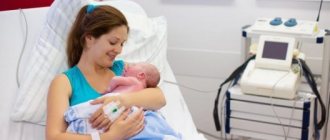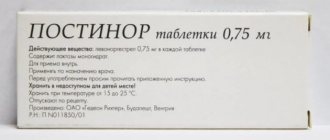The birth of a child is a joy for both parents, but for a woman it is also a real test for her body. In the process of bearing a baby, a woman’s body undergoes dramatic hormonal and physiological changes. Regardless of the method by which the baby is born, surgical or natural, his mother will still need some time to restore the normal functioning of all functions and systems of her body.
Many women are well aware that after an operation it takes much more time to recover, and therefore they are interested in how long it will take for the first menstruation to begin after a cesarean section, what course of menstruation is considered normal, and when it is better to seek help from a specialist. We will try to answer these and many other questions in this article.
When does the first period begin after a cesarean section?
The healing process begins immediately. Every day our uterus begins to contract. Even during a hospital stay, doctors very often prescribe drugs to contract the uterus. Normally, the uterus should contract up to 1 cm per day.
During healing there must be some discharge, otherwise known as lochia. They should never be confused with menstruation. At first they are red in color, very often there are clots in such secretions, you should not be afraid of this, the healing process is normal.
If everything goes well, the discharge thickens, becomes darker in color and decreases in quantity. At the very end they become light and stop completely. When the lochia disappears, it is believed that the scar on the uterus has healed and the body has returned to its normal rhythm.
Causes for concern
If there are any changes in the volume or nature of the discharge, you should definitely seek medical help in the following cases:
- The smell of the discharge changed and became pungent and purulent. This most often indicates the occurrence of endometritis - inflammation of the inner surface of the uterus. Body temperature rises, abdominal pain intensifies, and general health worsens. After a caesarean section, endometritis develops more often than after a natural birth.
- The volume of bloody things has increased sharply or their number does not decrease for a long time - this indicates the development of late hypotonic bleeding. After a cesarean section, they occur more often, since due to the presence of a suture on the uterus, it cannot contract completely well. If there is heavy bleeding (more than one pad per hour), you should urgently call an ambulance.
- The discharge suddenly stopped - the outflow of lochia from the uterine cavity was disrupted. This may be caused by a backward bending of the uterus. If their stagnation is not prevented, endometritis may develop.
- Curdled discharge and itching in the vagina indicate the presence of candidiasis colpitis (thrush). The risk of its development is associated with taking antibiotics after surgical delivery.
What are they?
A woman must monitor the nature and process of cleansing the uterus.
Here are a few factors that should alert you:
- If the discharge stops suddenly, before the 6th postpartum week. After all, if the suckers suddenly stopped, this means that the contractility of the uterus has been disrupted, which indicates its insufficient cleansing. Or a spasm of the cervix occurred, i.e. The cervix has closed and the discharge does not come out. The accumulation of lochia inside may cause an inflammatory process or postpartum endometritis
- Very scanty discharge in the first days . It is also a signal of poor cleansing of the uterus.
- Severe aching pain in the lower abdomen. Of course, pain will simply be present in any case, but if it is of such a nature that it is impossible to stand up or move, then an alarm must be declared.
- Discharge in large quantities, when you need to change the pad every 2 hours , with blood clots. In this case, there may be a risk of intrauterine bleeding. Of course, we do not forget about the individuality of each organism, but nevertheless, your attending physician should know about the amount of discharge.
- Unpleasant pungent odor. We always pay attention to the smell of lochia. It is very important. The presence of an odor indicates the penetration of bacteria into the body, where an inflammatory process very quickly occurs on the unprotected surface of the wound, which sometimes cannot be stopped only by selecting a course of antibiotics, and surgical intervention is also used - curettage of the uterine cavity.
- The color is bad. It should not be deep scarlet or bright in color. If the blood is bright red when released, then this is considered a clotting disorder and the opening of internal bleeding. Immediate hospitalization is required. If at least one of these signs is present, this is a reason to contact a gynecologist. Be sure to try to empty your intestines and bladder in the first days after birth. The contents in them put pressure on the uterus and lead to stagnation of secretions, creating a beneficial environment for the proliferation of bacteria that lead to the inflammatory process.
Normally progressing lochia is a sign that everything is fine with you.
When the lochia disappears, it is believed that the scar on the uterus has healed and the body has returned to its normal rhythm. Now you can wait for your real period.
The timing of the onset of the menstrual cycle varies from person to person. The time of their onset depends on:
- The age of the woman giving birth. In younger people, healing is faster and menstruation will begin earlier.
- General physical condition of the body. After a caesarean section, anemia is common due to blood loss during childbirth.
- If there were various pathologies during pregnancy.
- Your psycho-emotional state also plays an important role in restoring the menstrual cycle.
If suddenly, for some reason, you have no lactation and you are not breastfeeding, then in this case the menstrual cycle after a cesarean section begins 8 weeks after birth. In general, it is considered normal when the first menstruation after a cesarean section appears after 2-3 months. Doctors recommend being examined by a doctor after 2 months of surgery.
https://youtu.be/0IyLEXDr2L8
Normal discharge after surgical delivery
Immediately after the operation, the woman is in the intensive care unit under constant monitoring and medical supervision. Doctors monitor the indicators of the cardiovascular system and the condition of the uterus. early hypotonic bleeding may begin.
.
To prevent it, special substances are administered that cause contraction of the uterine muscles (oxytocin, methylergometrine).
- In the first 5–7 days, the lochia is red in color with clots
, reminiscent of normal menstruation, but more abundant, and has a musty smell. During this period, up to 500 ml can be released. The diaper or pad fills completely in 1 – 2 hours. Every day, a doctor in the postpartum department examines the discharge and checks with the woman about its quantity. Discharge intensifies when walking, palpating the abdomen, breastfeeding - in these cases, the uterus contracts better and expels the contents out; - Then the lochia gradually darken and acquire a red-brown color
. Their number gradually decreases; - By the end of 4–5 weeks, the lochia is scanty, dark, spotting
; - By 6–8 weeks,
the process of restoration of the uterine mucosa is completely completed.
The discharge becomes light mucous
and is no different from that before pregnancy.
The intensity and nature of the discharge in the first week after birth depends entirely on how well the uterus contracts. After a caesarean section, this process slows down somewhat, as some of the muscle fibers have been damaged.
We also recommend reading: Early symptoms of pregnancy
To stimulate uterine contractions and prevent late hypotonic bleeding
For the first three days, they continue to inject oxytocin and advise the young mother to follow
the following recommendations:
- Go to the toilet on time, because a full bladder prevents the uterus from contracting well.
- Breastfeed your baby on demand, not by the hour. Frequent breastfeeding stimulates a woman’s production of her own internal oxytocin. At the same time, during feeding, many mothers feel contraction of the uterus and increased discharge.
When breastfeeding
All women who have given birth in the usual way and those who gave birth to babies by caesarean section are required to breastfeed. If your baby actively eats mother's milk, then the onset of the first period during breastfeeding comes a little later.
This is explained by the fact that during lactation the hormone prolactin becomes very active in the female body. Prolactin suppresses the activity of other hormones found in the ovaries. They seem to be in a sleepy state, the eggs do not mature, and there are no periods.
Gynecologists have often observed that with active breastfeeding, menstruation may not occur for one year. And if everything goes as usual, as soon as we start feeding our growing baby something new and introducing additional complementary foods, then the menstrual cycle begins.
Based on the above, when answering the exciting question, when does menstruation begin after a cesarean section during breastfeeding, we can say that on average, the menstrual cycle begins 4-5 months after the operation.
What is it: lochia, menstruation or bleeding
If intense blood loss began less than a month after cesarean section, this is not lochia - they should, on the contrary, decrease by this time, and not menstruation, which, as already mentioned, can resume in a month and a half, and then in the absence of lactation. The cause of heavy discharge may be a clot, which consists of fragments of placental tissue and blood from blood vessels ruptured during childbirth. In this case, the woman should immediately consult a doctor to prevent the spread of inflammation. Perhaps, to solve the problem, she will be prescribed curettage: removal of clots along with the endometrial layer lining the uterine cavity. In the absence of indications for mechanical cleaning, treatment can be conservative (medicines), as well as using massage or vacuum.
Menstruation, lochia and bleeding differ in timing and intensity of discharge
Which ones should they be?
Don't be alarmed if your first period is quite heavy. This is considered the norm. We monitor our condition very carefully, no stress, either physical or emotional. Let the whole world wait with its problems.
Now you only need to take care of yourself and your baby. If your condition worsens, be sure to visit a gynecologist. Regulation of the menstrual cycle takes place in the first 3-4 months after childbirth. In extreme cases, after six months the cycle should become fully formed and regular. If this does not happen, then seek help from specialists.
Scanty periods are also a cause for concern; their reason may be that the scar on the uterus is preventing full contractions. And stagnant processes may well form. And heavy menstruation can be compared with another problem - uterine bleeding, which also serves as a reason for mandatory seeking help from a medical institution.
It is undesirable to use new-fangled aromatic pads and especially tampons during discharge. Doctors often recommend using sterile gauze. After all, by the color and even the smell of the discharge, you can determine that something has gone wrong and urgent medical help is needed.
When should you see a doctor?
The reason for contacting a doctor and looking for the causes of disorders may be the absence of menstruation for six months if a woman does not breastfeed, or for a year if she breastfeeds and uses complementary foods for baby food.
The first 2-3 cycles after the onset of menstruation may be somewhat irregular. But if within six months from the first menstruation the cycle has not become regular, you should definitely consult a doctor.
You should also go to the doctor if your periods after a cesarean section are very painful, difficult, with fever, deterioration in health, severe pain in the lower back and lower abdomen. Unusual discharge should also alert you - menstrual discharge with foam, a strong unpleasant odor, the presence of large blood clots - all this requires examination and treatment.
How long does the first period last after cesarean?
The first menstruation usually takes place without a mature egg, since sufficient restoration of the body has not yet occurred. Menstruation will be quite intense, the duration can be 7 days. Subsequently, the balance is gradually restored along with your body, the ovaries begin their work and the duration of menstruation becomes the same as it was before childbirth.
Usually, always after childbirth, even if it was performed by caesarean section, the cycle becomes smooth, painful periods disappear, and the nervous manifestations of premenstrual syndrome go away. The length of time from one period to the next may change, but the time frame should remain the same - from 21 to 35 days. It doesn’t matter whether you had surgery or didn’t have a menstrual period, a healthy woman should recover completely, just like before giving birth.
Visit a gynecologist
A routine examination after a CS is carried out 1–2 months after birth. If there are no complications, the girl does not have to worry about her health and takes care of the child. Sometimes problems may arise, then you should immediately contact a gynecologist. For example:
- if a year after birth, menstruation does not occur during breastfeeding. During lactation, critical days may be absent for a long time. But if your period does not start after a year, it is better to go to the doctor;
- if after 3 months there is no menstruation, and the child is on IV;
- if after the start of discharge, the cycle has not been restored within six months.
Time frame for the restoration of the menstrual cycle.
Experts believe that the period for restoring the menstrual cycle is from four to six months after the first menstruation. Precisely menstruation, not postpartum discharge. If this is not the case, then you should definitely visit a doctor and discuss your concerns with him.
You also need to pay attention to the abundance of menstruation, if for the first three cycles this is considered the norm, then later periods that are too heavy after childbirth or that occur too often, then this is also a reason to visit the clinic.
Restoring the menstrual cycle after a cesarean section always takes a longer period due to the scar on the uterus, but over time the cycle becomes constant and stable. You should not think that if there are scars on the body of the uterus, then menstruation will be painful. With normal healing, menstruation occurs as usual, without causing concern to the woman.
Basic recommendations in case of failure to restore the menstrual cycle after cesarean section.
You should never forget about the enormous stress on the body during pregnancy. Then the operation, breastfeeding. All these factors cause a deficiency of nutrients for the normal functioning of the ovaries. Therefore, the main advice is a normal balanced diet .
With the birth of a baby, additional troubles are added to its development, hence the load on the nervous system. Whenever possible, you should pay attention to proper rest and avoid increased fatigue.
Often, when the body is weakened, our old chronic diseases take over, especially if the pathologies were associated with the endocrine system. Their exacerbation may also be associated with a delay in the onset of the menstrual cycle.
If, after a caesarean section while breastfeeding, menstruation does not occur within a year, you need to contact an antenatal clinic.
Features of menstruation after surgery
Menstruation after cesarean section may be irregular. Its normalization lasts for 3–4 months from the first menstruation. In this case, the interval between “critical” periods should be no less than 21 days and no more than 35. The parameters for the duration of menstruation itself vary normally from 3 to 7 days. At the same time, one should not forget about contraception. In the absence of menstruation and during breastfeeding, cases of repeated pregnancy have been recorded many times.
The first menstruation may occur without ovulation, since ovarian function has not yet recovered. As the hormonal system improves, the following month is characterized by the maturation of the egg and the presence of ovulation.
In the first month, menstruation can be very heavy. This condition is considered normal if the woman does not experience other warning symptoms. After a caesarean section, monitoring by a gynecologist is necessary 1–2 months from the date of birth. Many women notice that after pregnancy, periods are more regular, almost painless and do not cause discomfort.
Common complications after cesarean section
The most common complication after a cesarean section is endomyometritis or inflammation of the uterus . Even while in the maternity hospital, women in labor are required to be prescribed a course of antibiotics, since during the operation there was direct contact of internal organs with air, where complete sterility is simply impossible to achieve. Taking antibiotics after surgery is mandatory to prevent inflammatory processes.
In the future, a woman must carefully monitor the state of her female health. No hypothermia, which is always fraught with inflammatory processes. You also need to take care of intimate hygiene.
You shouldn’t accumulate a lot of urine in the bladder; it begins to put pressure on the uterus. There is no need to douche or use tampons during your period. It is advisable to begin sexual activity no earlier than two months after childbirth.
After all, don’t forget that there is a bleeding wound inside, to which harmful bacteria cling. Any inflammatory diseases are very, very dangerous after surgical delivery.
If suddenly you feel an unpleasant odor during menstruation, be sure to consult a doctor. This is considered the first sign of endometritis. This is why gynecologists recommend not using scented pads. And of course, if you have aching pain in your stomach and your temperature has risen, then you need to sound the alarm.
What is a caesarean section and what are the risks of this operation?
This operation is common and should not be alarmed. The operation is performed by making an incision in the abdominal cavity. The uterine cavity and amniotic sac are opened through the incision. After this, the child is removed. All manipulations are carried out under general conditions. The woman does not feel anything during it. After a week, as a rule, there is a discharge from the hospital. Doctors know better how and what in this situation will be the best solution for you and the child. There are pros and cons to any surgical procedure. Caesarean is no exception. No doctor will perform an operation if there is no indication for it. It is prescribed in the following cases:
- advanced form of diabetes;
- if a woman is undergoing pregnancy;
- narrow pelvis: if there is such a pelvis, the passage of the child will be problematic and traumatic for him and for the mother;
- with malformations of the genital organs;
- vision problems - meaning severe myopia;
- genital herpes;
- late toxicosis.
Rehabilitation
For the normal formation of the menstrual cycle after a cesarean section, a woman must make some effort. A negligent attitude towards one's health can even lead to death.
So, what we need first of all is adherence to a certain regime . Moreover, this recommendation will not hurt both the mother and her baby. It's for everyone's benefit.
Secondly, you need to try to get enough sleep if possible; if you can’t at night, then look for moments to rest during the day. Do not refuse any help from your family and friends.
Thirdly, these are walks in the fresh air, without rushing anywhere, calmly walk with your baby in the park. Running around the supermarket with a cart and stroller does not count as a walk.
How to help the body recover
In order for the female body to recover quickly after surgical childbirth, it is necessary to ensure that simple rules are followed:
- establish a daily routine, allocate enough time for sleep and rest, spend more time in the fresh air, walk, do not overexert yourself;
- eat a balanced diet, give preference to a healthy diet;
- maintain sexual rest for two months after surgical birth;
- since after cesarean it is advisable to plan the next baby no earlier than 3 years later, contraception should be used;
- You should temporarily refrain from taking baths and visiting bathhouses, swimming pools and open reservoirs; hygiene procedures are best carried out in the shower;
- you can’t douche;
- You need to stop using sanitary tampons in favor of pads.
Using these simple recommendations, a woman can quickly restore her health and return to the everyday joys of life.
Nutrition
You should not immediately go on a diet after giving birth, even if the baby is bottle-fed. And we really want to show the world our impeccable shapes as quickly as possible, put on our favorite tight jeans or something else attractive that we even forgot a little about during pregnancy. We must eat nutritiously and of high quality, and, if possible, with vitamins.
How to regulate your monthly cycle
It makes sense to discuss the issue of stabilizing menstruation in advance with a gynecologist. Especially if there were complications during childbirth. The general recommendations of experts are as follows:
- the need to enrich your menu with vitamins and microelements;
- doing dosed physical exercise (including yoga, swimming);
- choosing comfortable underwear that would not disrupt blood microcirculation in the pelvic organs;
Wearing comfortable underwear is a preventive measure to stabilize the cycle - eliminating reasons for strong emotional shocks and stress;
- drinking sufficient volumes of fluid (but only if the mother has not chosen the method of gradually weaning the baby from the breast);
- ensuring regular sexual contact (but not earlier than 6–8 weeks after birth), not forgetting about protection.
This is interesting. If a woman suffers from postpartum depression, then she should take light sedatives, drink herbal infusions and, in especially advanced cases, visit a psychologist.
Do not be nervous!
Probably this point should be put in first place. Because, as we all already know, all diseases are caused by nerves.
Of course, after childbirth with surgical intervention, the period of rehabilitation and recovery for a woman is longer and more painful than after a normal one, but with due attention and care, the unpleasant consequences of recovery after a cesarean section go away over time.
And at the end of the article I would like to wish all women to love, groom and cherish themselves, take care of their body and health. Because we often forget about ourselves, trying to please everyone around us. Taking care of ourselves, being healthy, beautiful and loved is our main task in life. If we are healthy, our baby will be happy.
Briefly about the physiology of menstruation
Before you understand the nuances of resuming your cycle after a cesarean section, you need to clearly understand the nature of menstruation.
So, the physiological process, which is caused by the rejection of the epithelium (mucosal surface) of the uterus due to cyclic changes in hormonal levels, is called menstruation (menstruation, regulation). These transformations occur in three cycles.
Menstruation is a physiological process that occurs regularly in the body of a woman of reproductive age.
Table: phases of the menstrual cycle
| Phase | Deadlines | What's happening | Result |
| First (follicular) | Two weeks from the first day of your last period | Follicles (components of the egg) develop. | 1–2 dominant follicles stand out and grow. |
| Second (ovulatory) | Days 14–16 of the cycle | The walls of the follicle rupture, from which a mature egg emerges. | Ovulation occurs, meaning the woman can become pregnant. |
| Third (luteal) | 13–14 days from ovulation | The uterus is preparing for the implantation of a fertilized egg. If it does not occur, then the inner mucous membrane swells and the tissue begins to die. | Your period begins. |
This is interesting. Each phase of the monthly cycle has its own coordinating hormone. For example, at the stage of ovulation it is estradiol, at the stage of the luteal phase it is progesterone.
Heavy periods: reasons, what to do
Reasons for heavy periods include:
- development of endometriosis;
- slow healing of postoperative wounds;
- postoperative endometrial hyperplasia;
- pathology of the coagulation system;
- Iron-deficiency anemia;
- inflammation of the genital organs;
- reproductive system infections;
- unbalanced diet;
- incomplete discharge of placental elements;
- a scarring process that complicates the normal rejection of the epithelium (large scar, keloid scar);
- inflammatory diseases of other pelvic organs;
- neoplasm.
Heavy periods after cesarean section at first are considered normal; often there is no need to do anything. If blood loss per day is more than 120 milliliters, then such periods will be considered heavy.
If heavy blood loss is detected, you should immediately contact a gynecologist. A clear sign of such a situation for a woman will be an increased need to change pads: if one is not enough for a couple of hours, then this is an alarming symptom.
At the appointment, the gynecologist will conduct:
- examination of the female genital organs in the mirror;
- taking a smear from the urethra and vagina;
- will refer you for general and biochemical blood tests, ultrasound of the pelvic organs;
- will offer to determine Rh and blood group;
- will issue a referral for a blood test for major infections.
The entire history of life, the course of pregnancy and childbirth will also be carefully collected for a comprehensive assessment of the situation, so the doctor needs to answer all questions in detail without embarrassment. If necessary, the gynecologist will refer the woman to other specialists: therapist, coloproctologist, gastroenterologist, hematologist and others.
Examination by a gynecologist
If it takes a long time
If the critical days go on for a long time, then there is a risk of uterine bleeding. The normal duration of the cycle after cesarean section is at least 3 days and no more than 9-10. If blood is lost for more than a week in consistently large quantities, you should urgently consult a gynecologist.
Sources of bleeding can be vessels in the uterus, endometriotic formations, cysts, injured pelvic organs and other formations. A full examination, including laboratory and instrumental methods, will help to identify the cause. Bleeding is often caused by incompetent sutures on the uterus, inflammation or infection.
Painful
Painful sensations are often present in women after cesarean section and persist throughout the first few cycles; such sensations in the mother who gave birth can be caused by:
- lack of sleep, disrupted routine;
- postoperative injury, slow recovery;
- increased sensitivity to pain;
- bend of the uterus;
- inflammation;
- adhesive process;
- endometriosis;
- uterine fibroids;
- endometritis;
- inflammatory diseases of the genitourinary system, distal intestines.
Painful periods require you to find time and visit a gynecologist to identify the cause. Sometimes pain during menstruation goes away on its own after a few months under the influence of restoration of hormonal levels and healing of the suture, but you should not rely only on this scenario.











